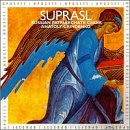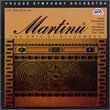| All Artists: Russian Orthodox Chant, Anatoly Grindenko, Russian Patriachate Choir Title: Suprasl Orthodox Mosaic Members Wishing: 0 Total Copies: 0 Label: Opus 111 Release Date: 3/14/2000 Genre: Classical Styles: Opera & Classical Vocal, Historical Periods, Early Music, Sacred & Religious Number of Discs: 1 SwapaCD Credits: 1 UPC: 709861302291 |
Search - Russian Orthodox Chant, Anatoly Grindenko, Russian Patriachate Choir :: Suprasl Orthodox Mosaic
 | Russian Orthodox Chant, Anatoly Grindenko, Russian Patriachate Choir Suprasl Orthodox Mosaic Genre: Classical |
Larger Image |
CD DetailsSimilar CDs
|
CD ReviewsAn overwhelming experience of Orthodox chant LC | BC, Canada | 02/16/2003 (5 out of 5 stars) "Since the early 1990s, the excellent French label Opus 111 has released a number of recordings by the Russian Patriarchate Choir, which was founded in 1980 by Anatoly Grindenko. Grindenko, a successful performer on the double-bass and viola de gamba, has combined a devotion to the living tradition of the Orthodox liturgy with important and original musicological scholarship. The result has been the careful editing and inspired performance of a number of manuscripts representing early, and sometimes all but lost, traditions of Orthodox chant.The present recording would not have been possible without the scholarship of Professor Anatoly Konotop, a Doctor in History of Art. The manuscript of the "heirmologion" (a collection of Orthodox liturgical chants) of the Suprasl' monastery, in present day Poland, was compiled between 1598 and 1601, on the centenary of the monastery's founding. The 1,130 page illuminated manuscript was actually lost in the 1930s and only found again in 1972 by Prof. Konotop, who deciphered the early notation and reconstructed damaged sections.The Suprasl' chants reflect the diverse origins of the monastic community itself. Monks from Mount Athos and the Caves in Kiev, as well as the Balkans, contributed their traditions to both the monastery and its chant. Characterized by very drawn out melodic lines over (and sometimes under) sustained notes, a distinct intonation, a way of phrasing similar to the melismatic style (one syllable sung over a whole line of notes) of Greek and other chant, and elaborated meaningless syllables, the Suprasl' chants combine elements from a variety of ancient traditions. The result is a sound of striking power and beauty.Konotop remarks that "the long-breathed quality of the melodies would have matched the slow, calm rhythm of the services, during which nothing was sung at a rapid tempo, [but] rather with the kind of meditative concentration which fosters a state of prayer." Though an interesting comment about the historical context, this quite fails to communicate the singular character of these chants, and indeed how positively exhilarating some of them are. One frequently gets an uncanny sense of soaring freely through space while at the same time moving so slowly that one can only perceive motion at all over several minutes. This amazing effect is, of course, only achieved with the equally amazing vocal abilities of Grindenko's choir. As the Gramophone reviewer of this recording remarks, "it is difficult to believe that any of the singers ever breathe, so naturally do they phrase these [huge melodic arches]."The program itself is presented as an "Orthodox Mosaic," and includes a variety of hymns and other liturgical chants, most sung with the distinctive sustained notes supporting the other singers. The highlights are the two eleven and half minute chants, the "Hymn of the Cherubim" and the "Stikhira for the procession of the Shroud," but the recording is a powerful, fascinating and important one from beginning to end. Opus 111's recording quality is very fine, as usual. As mentioned above, the Russian Patriarchate Choir have several recordings of Othodox Russian music, and there are a handful of other good, commercially available recordings of Russian chant. But the beauty of this music, the quality of the singing and the recording, and perhaps the fact that the music, though early, represents a variety of Eastern chant traditions, should make this CD a first choice for anyone interested in exploring the musical world of the Orthodox Church.Finally, a note about some related recordings: there are not many. At present, I know of only three other recordings of Suprasl' chant, all produced in collaboration with Prof. Konotop. The Choir of St. Daniel's Monastery, directed by Georgy Safonov, has made two recordings, and the Male Choir of the Holy Trinity Monastery Representation Church, directed by Vladimir Gorbik, one. Unfortunately, these recordings have no regular distribution outside of Russia. Musica Russica seems to be the one place in the West from which they can be obtained. They are well worth finding, though, especially if one enjoys "Suprasl': An Orthodox Mosiac." They are surprisingly well recorded, and as authentic as it gets. They contain some spoken text and use vocal drones to great effect. Some of the liner notes are in Russian only." Spine-tingling, overpowering music Sator | Sydney, Australia | 06/18/2005 (5 out of 5 stars) "Anatoly Grindenko is a musician embarking on a journey to rediscover his musical heritage that had been buried by the passage of time. The primordial sounds that he unearths from centuries long gone have a spine-tingling intensity that in a crowded early music field, are simply remarkable. Nothing in the canon of Western plain chant even remotely prepares the listener for the impact of its breathtaking hypnotic power. This effect is truly overwhelming to listen to.
A viola da gamb player by training, for this recording Grindenko has worked closely with the musicologist Anatoly Konotop to decipher the mysterious ancient cryptic notation that has survived. Anatoly Konotop himself contributes the liner notes in which he describes the music of the heirmologion of Suprasl' as "one of the supreme jewels of the vocal art of ancient Russia". The heirmologon on this CD was compiled between 1598 and 1601 at the monastery of Suprasl. The music here originates from a manuscript compiled during the last two years of the 16th century and the first year of the 17th at the Polish Monastery of Suprasl. This book was thought lost around the 1930s, only to be miraculously recovered in 1972 by Anatoly Konotop, whose dedicated research, restoration and transcription provides the basis for this recording. What makes this release even more fascinating is that the plain chant in this manuscript originates from sources as diverse as those of Mount Athos and the Kievan Monastery of the Caves with elements of Greek, Bulgarian, Rumanian, Ukranian, Russian and Byzantine chant. Ivan Moody writing in Goldberg early music magazine gave this CD the maximal five stars - an accolade awarded by Goldberg strictly to only a select few recordings. None other than Paul Hillier (arguably the leading choral director in the world today), said in an interview with Goldberg early music magazine in which he listed his 10 desert island CDs: "I buy every recording that Anatoly Grindenko and his Russian male choir make. For this list I choose Russian Medieval Chant-the Divine Liturgy of St John Chrysostom (Opus 111). (Their CD of 19th-century sacred music is also delicious.)" I also have the Divine Liturgy of St John Chrysostom he mentions, however for me this Suprasl CD is the one that totally bowled me over first. So if you have ever even remotely enjoyed recordings of plain chant, Hildegard von Bingen - or for that matter any early music whatsoever - then you will find this a genuinely revelatory experience. Compared with the ultra-pure sounds of the likes of the Anonymous 4, the sounds here have a shock impact of an almost visceral intensity that is utterly staggering. Adding to the impact is the recording by Opus 111 which is class A audiophile quality. Potent stuff!!!!" |


